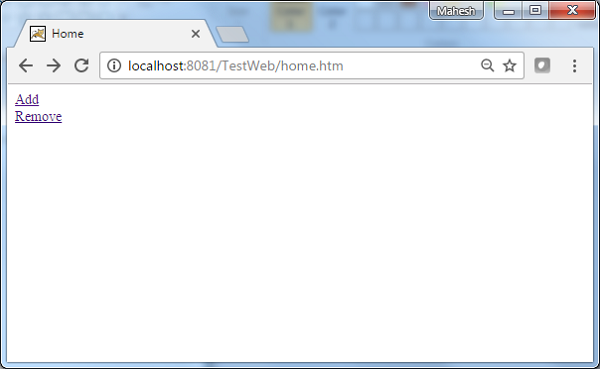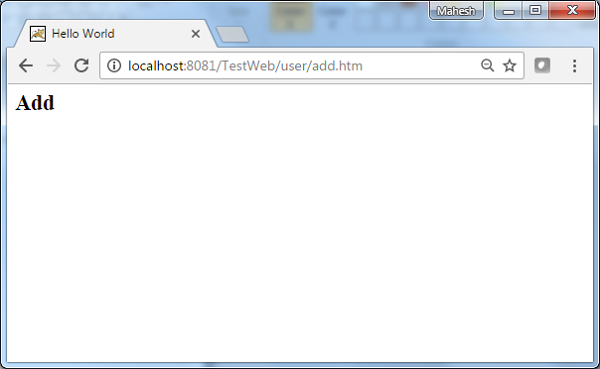Spring MVC - пример контроллера с несколькими действиями
В следующем примере показано, как использовать Multi Action Controller с помощью инфраструктуры Spring Web MVC. ВMultiActionController class помогает сопоставить несколько URL-адресов с их методами в одном контроллере соответственно.
package com.tutorialspoint;
import javax.servlet.http.HttpServletRequest;
import javax.servlet.http.HttpServletResponse;
import org.springframework.web.servlet.ModelAndView;
import org.springframework.web.servlet.mvc.multiaction.MultiActionController;
public class UserController extends MultiActionController{
public ModelAndView home(HttpServletRequest request,
HttpServletResponse response) throws Exception {
ModelAndView model = new ModelAndView("home");
model.addObject("message", "Home");
return model;
}
public ModelAndView add(HttpServletRequest request,
HttpServletResponse response) throws Exception {
ModelAndView model = new ModelAndView("user");
model.addObject("message", "Add");
return model;
}
public ModelAndView remove(HttpServletRequest request,
HttpServletResponse response) throws Exception {
ModelAndView model = new ModelAndView("user");
model.addObject("message", "Remove");
return model;
}
}<bean class = "org.springframework.web.servlet.handler.BeanNameUrlHandlerMapping"/>
<bean name = "/home.htm" class = "com.tutorialspoint.UserController" />
<bean name = "/user/*.htm" class = "com.tutorialspoint.UserController" />Например, используя приведенную выше конфигурацию, если URI -
/home.htm, DispatcherServlet перенаправит запрос в UserController home() метод.
user / add.htm запрошен, DispatcherServlet перенаправит запрос в UserController add() метод.
user / remove.htm запрошен, DispatcherServlet перенаправит запрос в UserController remove() метод.
Для начала давайте создадим рабочую среду IDE Eclipse и будем придерживаться следующих шагов для разработки веб-приложения на основе динамических форм с использованием Spring Web Framework.
| Шаг | Описание |
|---|---|
| 1 | Создайте проект с именем TestWeb в пакете com.tutorialspoint, как описано в главе Spring MVC - Hello World. |
| 2 | Создайте класс Java UserController в пакете com.tutorialspoint. |
| 3 | Создайте файлы просмотра home.jsp и user.jsp в подпапке jsp. |
| 4 | Последний шаг - создать содержимое исходных файлов и файлов конфигурации и экспортировать приложение, как описано ниже. |
UserController.java
package com.tutorialspoint;
import javax.servlet.http.HttpServletRequest;
import javax.servlet.http.HttpServletResponse;
import org.springframework.web.servlet.ModelAndView;
import org.springframework.web.servlet.mvc.multiaction.MultiActionController;
public class UserController extends MultiActionController{
public ModelAndView home(HttpServletRequest request,
HttpServletResponse response) throws Exception {
ModelAndView model = new ModelAndView("home");
model.addObject("message", "Home");
return model;
}
public ModelAndView add(HttpServletRequest request,
HttpServletResponse response) throws Exception {
ModelAndView model = new ModelAndView("user");
model.addObject("message", "Add");
return model;
}
public ModelAndView remove(HttpServletRequest request,
HttpServletResponse response) throws Exception {
ModelAndView model = new ModelAndView("user");
model.addObject("message", "Remove");
return model;
}
}TestWeb-servlet.xml
<beans xmlns = "http://www.springframework.org/schema/beans"
xmlns:context = "http://www.springframework.org/schema/context"
xmlns:xsi = "http://www.w3.org/2001/XMLSchema-instance"
xsi:schemaLocation = "
http://www.springframework.org/schema/beans
http://www.springframework.org/schema/beans/spring-beans-3.0.xsd
http://www.springframework.org/schema/context
http://www.springframework.org/schema/context/spring-context-3.0.xsd">
<bean class = "org.springframework.web.servlet.view.InternalResourceViewResolver">
<property name = "prefix" value = "/WEB-INF/jsp/"/>
<property name = "suffix" value = ".jsp"/>
</bean>
<bean class = "org.springframework.web.servlet.handler.BeanNameUrlHandlerMapping"/>
<bean name = "/home.htm"
class = "com.tutorialspoint.UserController" />
<bean name = "/user/*.htm"
class = "com.tutorialspoint.UserController" />
</beans>home.jsp
<%@ page contentType = "text/html; charset = UTF-8" %>
<html>
<head>
<meta http-equiv = "Content-Type" content = "text/html; charset = ISO-8859-1">
<title>Home</title>
</head>
<body>
<a href = "user/add.htm" >Add</a> <br>
<a href = "user/remove.htm" >Remove</a>
</body>
</html>user.jsp
<%@ page contentType = "text/html; charset = UTF-8" %>
<html>
<head>
<title>Hello World</title>
</head>
<body>
<h2>${message}</h2>
</body>
</html>Как только вы закончите создание исходных файлов и файлов конфигурации, экспортируйте свое приложение. Щелкните правой кнопкой мыши свое приложение, используйтеExport → WAR File вариант и сохраните TestWeb.war в папке webapps Tomcat.
Теперь запустите сервер Tomcat и убедитесь, что у вас есть доступ к другим веб-страницам из папки webapps с помощью стандартного браузера. Теперь попробуйте URL-адрес -http://localhost:8080/TestWeb/home.htm и мы увидим следующий экран, если с веб-приложением Spring все в порядке.

Попробуйте URL http://localhost:8080/TestWeb/user/add.htm и мы увидим следующий экран, если с веб-приложением Spring все в порядке.
